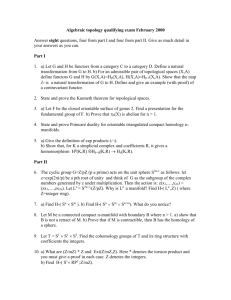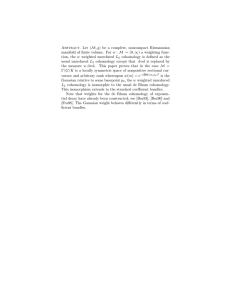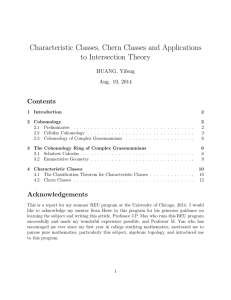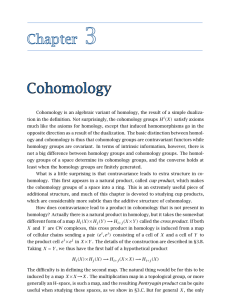Galois Cohomology (Study Group) homology (by Matthew Spencer) 1.1 Homology Topological space
advertisement
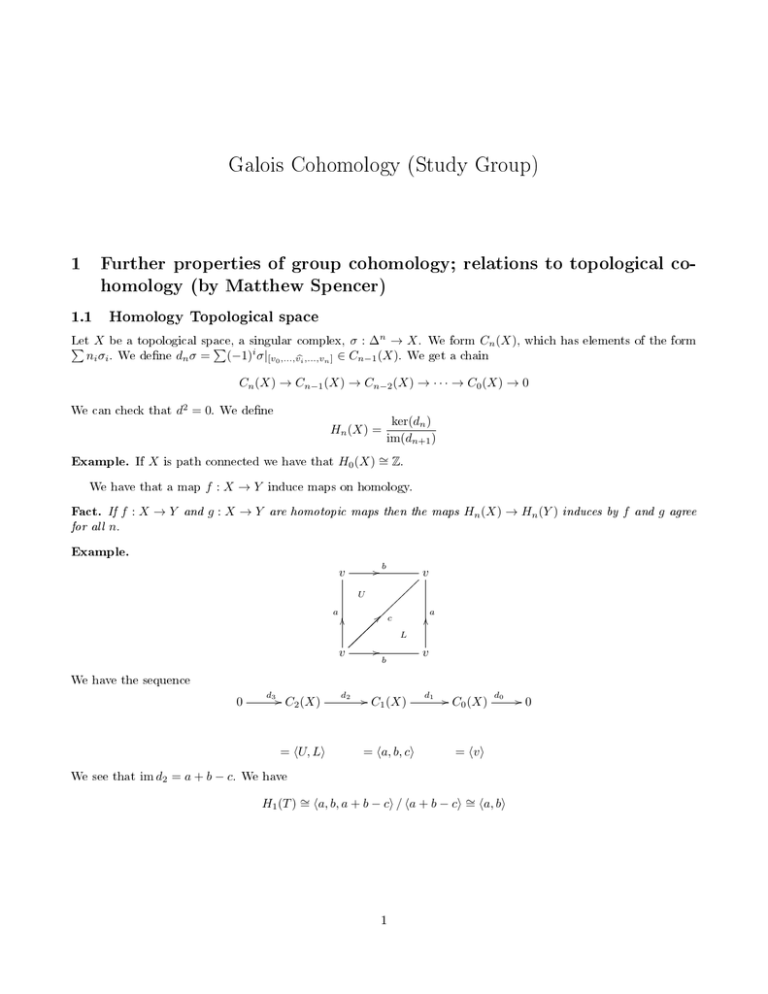
Galois Cohomology (Study Group)
1
Further properties of group cohomology; relations to topological cohomology (by Matthew Spencer)
1.1
Homology Topological space
Let X be a topological space,
complex, σ : ∆n → X . We form Cn (X), which has elements of the form
P
P a singular
i
ni σi . We dene dn σ = (−1) σ|[v0 ,...,vbi ,...,vn ] ∈ Cn−1 (X). We get a chain
Cn (X) → Cn−1 (X) → Cn−2 (X) → · · · → C0 (X) → 0
We can check that d2 = 0. We dene
ker(dn )
im(dn+1 )
Hn (X) =
Example. If X is path connected we have that H (X) ∼= Z.
0
We have that a map f : X → Y induce maps on homology.
Fact. If f : X → Y and g : X → Y are homotopic maps then the maps H (X) → H (Y ) induces by f and g agree
n
for all n.
Example.
/b
v
n
v
U
a
>
O
O
c
a
L
v
/
b
v
We have the sequence
0
d3
/ C2 (X)
= hU, Li
d2
/ C1 (X)
= ha, b, ci
d1
/ C0 (X)
d0
= hvi
We see that im d2 = a + b − c. We have
H1 (T ) ∼
= ha, b, a + b − ci / ha + b − ci ∼
= ha, bi
1
/0
1.1.1 Cohomology
We take a pair X, A where X is a topological space and A an Abelian group. We take the sequence
Cn (X) → Cn−1 (X) → Cn−2 (X) → · · · → C0 (X) → 0
and apply HomZ (−, A) to it, to get another chain which we denote C n (X, A). We dene the map δ between them
by δf (a) = f (da), again we see δ 2 = 0. Again we dene H n (X, A) = ker δ n / im(δ n−1 ).
Universal Coecient Theorem. H
1.1.2 Cup product
n
(X, A) ∼
= Hom(Hn (X), A) ⊕ ExtZ (Hn−1 (X), A)
Let A be a ring and let φ ∈ C k (X, A) and ψ ∈ C l (X, A). We dene the cup product as
(φ ∪ ψ)(σ) = φ(σ|[v0 ,...,vk ] ) · ψ(σ|[vk+1 ,...,vk+l ] ) ∈ C k+l (X, A)
We have
δ(φ ∪ ψ) = δφ ∪ ψ + (−1)k φ ∪ δψ
So we have a well dened map H k (X, A) × H l (X, A) → H k+l (X, A) dened as [φ] × [ψ] 7→ [φ ∪ ψ].
Let H ∗ (X, A) = ⊕H n (X, A), this is (by the previous map) a graded ring. Note that α ∪ β = (−1)kl β ∪ α.
1.1.3 Cap product
Let n ≥ p, φ ∈ C p (X, A) and σ ∈ Cn (X, A) (note that Cn (X, A) is taken by considering Cn (X) and applying
− ⊗Z A to it). We dene the cap product as
σ ∩ φ = φ(σ|[v0 ,...,vp ] )σ[vp+1 ,...,vn ] ∈ Cn−p (X, A)
We have
d(σ ∩ φ) = (−1)p (dσ ∩ φ − σ ∩ δφ)
Let K be a commutative ring with unit. Using the above, we have the map
∩ : Hn (X, K) × H p (X, K) → Hn−p (X, K)
Theorem 1.1.
Let M be a compact manifold without boundary, K -orientable with fundamental class [m] ∈
Hn (M, K). The map D : H k (M, K) → Hn−k (M, K) dened by D(α) = [m] ∩ α is an isomorphism.
1.2
Group Cohomology
Let G be a discrete group. Let F be a projective resolution of Z over Z[G], let M be a Z[G]-module. Consider the
resolution
Fi → Fi−1 → · · · → F0 → Z → 0
We want to apply (− ⊗Z M )G = (Fi ⊗ M )/ mod G − action, to it and get another chain sequence. We dene
Hn (G, M ) to be the homology of that chain. If instead we apply HomZ[G] (Fi , M ), then we call its homology
H n (G, M ).
We dene G-complex. A CW-complex with a G-action which respects CW-complex structure. We say that this
is free if G acts freely. If X is contractible, then Hn (X) = Hn {pt}. In particular
Cn (X) → Cn−1 (X) → · · · → C0 (X) → Z → 0
is a projective resolution of Z by Z[G]-module.
There exists a space k(G, 1) =: Y such that
1. Y is connected
2
2. π1 (Y ) = G
3. If X is the universal cover, X is contractible.
Fact. If X is a free G-complex, Y
the orbit X/G, then C∗ (Y ) = C∗ (X)G , where (−)G = Z ⊗Z[G] −.
This gives H∗ (G) = H∗ (Y ).
Let us now assume that G acts trivially on M , then Hn (Y, M ) = Hn (G, M ) and H n (Y, M ) = H n (G, M ).
If M has non-trivial G action, then H n (G, M ) = H n (Y, M) and Hn (G, M ) = Hn (Y, M) where M is a local
coecient system on k(G, 1).
k(G, 1) is an example of a classifying space for G, we call it BG.
Fact. If H ≤ G, we have a mapBH → BG. This induce a map on the cohomology (res
G
H)
: H n (G, A) → H n (H, A)
This is motivation for the next sentence: Suppose if we have a nite map f : X → Y , where this time X and Y
are manifolds with dimension n
H k (X) o
H k (Y )
=
=
/ Hn−k (Y )
Hn−k (X)
n
n
Now let H ≤ G with |G : H| < ∞, we have corH
G : H (H, A) → H (G, A) dened by
(corx)(σ0 , . . . , σn ) =
X
c−1 x(cσ0 (cσ0 )−1 , . . . , cσn (cσn )−1 )
c∈H\G
We get the identity
cor(α ∪ resβ) = (corα) ∪ β
3
